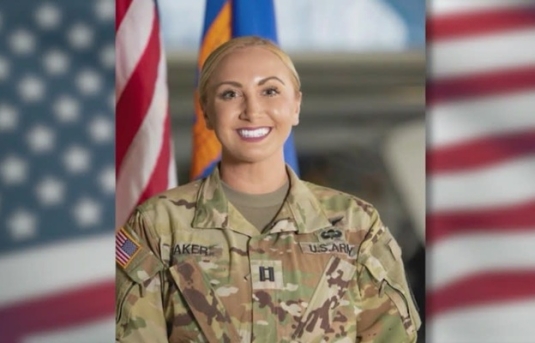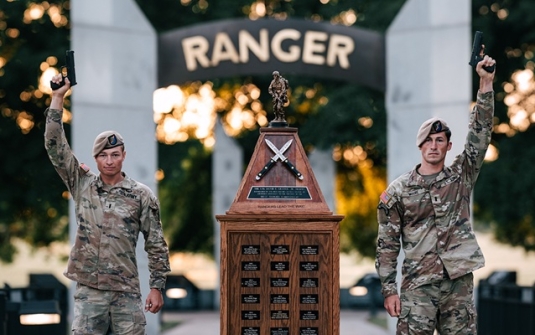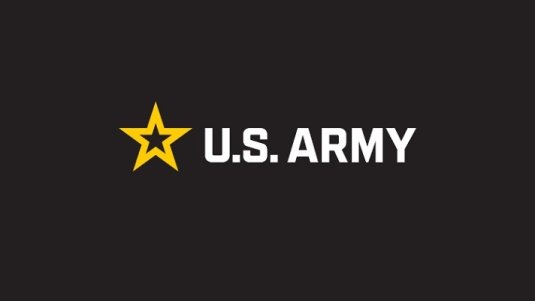The West Point Association of Graduates (WPAOG) has named the 2002 recipients of the Distinguished Graduate Award. This annual award has been bestowed upon those West Point graduates whose character, distinguished service, and stature draw wholesome comparison to the qualities for which West Point strives, in keeping with its motto: “Duty, Honor, Country.” View photos here. The 2002 Distinguished Graduate Award Recipients are:
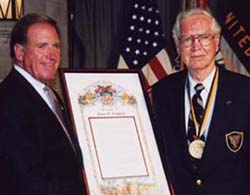
James R. Dempsey ’43
During his lifetime, James R. Dempsey has made an extraordinary series of contributions to America’s national security. One of 164 members of his war-shortened West Point class to earn pilot’s wings before graduation, he soon put his skills to the test flying dangerous, low-level, unarmed and unescorted photographic reconnaissance missions along the beaches of Normandy prior to the D-Day Invasion. Later, he again was put to the test on a far greater scale as director of the Convair/General Dynamics team charged with developing the Atlas Intercontinental Ballistic Missile. Not only did he bring this complex project to successful launch ahead of schedule, but he also provided the expertise that adapted the Atlas to launch our first astronaut into space following the Soviet Union’s success with Sputnik and their first cosmonaut. Even later, with AVCO, he would contribute to the successful development of re-entry systems for the Minuteman One missile and the heat shields for the Apollo return module.
Read More
After graduation, Lieutenant Dempsey completed P-38 training before joining the 34th Photo Reconnaissance Squadron in England. While completing 43 combat missions, he advanced from flight commander to squadron commander and was awarded the Distinguished Flying Cross for taking the first low-altitude photos of the Siegfried Line. After the war, he received a master’s degree in Aeronautical Engineering while a member of the first Air Force guided missile course at the University of Michigan. He then served as chief of guided missile projects in the Air Force Office of Research and Development and executive officer for the Deputy Chief of Staff for Development. In this latter position, he was involved in the Air Force reorganization that created the Air Research and Development Command, separating research and development of advanced technology from logistics. He then was one of the first Air Force officers to arrive at Patrick Air Force Base and place his imprint upon the seminal development of Cape Canaveral as a center for American missile technology. As operations officer for the missile test range, he had primary responsibility for the establishment of down-range monitoring stations and the installation of advanced instrumentation.
In 1953, he joined Convair, just a short while before the Department of Defense decided upon a national effort to develop the Atlas missile in 1954. Assigned as director of the Atlas program, Dempsey led the Convair/General Dynamics team that developed all facets of America’s first intercontinental ballistic missile. It would be the largest and most demanding technological task ever assigned to a private corporation. Because of a daunting time schedule, the Atlas missile was developed concurrently with the construction of eleven bases across the United States. Due to his managerial skills and singular devotion to mission accomplishment, the project was completed ahead of schedule and within budget tolerances. By 1960, the Strategic Air Command was able to conduct the first Atlas operational test launch. In that same year, the Collier Trophy, presented annually by the National Aeronautics Association for the greatest achievement in astronautics in America, was awarded to the United States Air Force and the Convair Division of General Dynamics. Jim Dempsey, now president of Convair/Astronautics, accepted the award on behalf of his company for accomplishments “that were vital to the security and space exploration needs of the United States and the free world” from President Eisenhower.
During the development of the Atlas, Dempsey also had the foresight to visualize its potential as a launch vehicle for both manned and unmanned space flights. When, following the success of its Sputnik launch in 1957, the Soviets launched a cosmonaut into space in 1961, the United States was able to send its own astronaut into space just ten months later — in a Mercury capsule aboard an Atlas missile adapted for the space program. In 1965, the Astronautics and Convair divisions of General Dynamics were combined as Convair, and Dempsey was named president. His most notable contribution in this capacity was the development of Centaur, the world’s first liquid hydrogen/oxygen space vehicle, as a second stage for the Atlas and Titan missiles.
In 1966, he joined AVCO and in 1968 was named vice president of its Government Products Group. At AVCO, his most significant projects were the re-entry systems for Minuteman One and the heat shield for the Apollo return module. Just before departing in 1975, he fostered the development of a boron fiber production process. He then continued to be active in personal business pursuits and served on the boards of several corporations and mutual funds. As vice president and, later, president of his class, he has been a staunch supporter of West Point and was instrumental in the development of the Flight Memorial, the Constitution Corner, and the 50th Anniversary Howitzer for the Class of January 1943.
In recognition of his bravery in combat, his contributions to missile technology and the defense of the United States, and his limitless vision that helped launch our exploration of space and victory in the Cold War, the Association of Graduates takes great pride in presenting the 2002 Distinguished Graduate Award to James Raymon Dempsey, USMA Class of January 1943.
Thomas B. Dyer
Chairman and CEO
GEN (R) Edward C. Meyer ’51
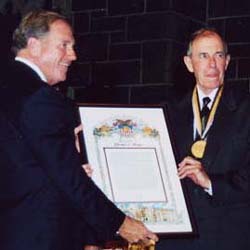
Born in St. Mary’s, Pennsylvania, General Edward C. “Shy” Meyer graduated from the United States Military Academy in 1951. Since then, he has served the nation, the Army, and West Point with great distinction. In particular, his service as a commander and staff officer in combat, his direction of Army modernization and force development during the Cold War, his contributions to strategic studies and joint operations, and his leadership of the Association of Graduates and other organizations have made him a prominent and distinguished figure in the effort to guarantee the security of the free world.
Read More
Commissioned a lieutenant in the Infantry, General Meyer’s first assignment was to Korea in 1952. There, he commanded a rifle company in the 40th Infantry Division and later served as battalion intelligence officer, receiving awards that included the Silver Star for gallantry in action and the Bronze Star with “V” device for heroic achievement.
The next phase of Shy Meyer’s career broadened his operational experience and continued his exposure to the political-military issues that he would face in the higher-level command and staff positions to which he would later be assigned. In addition to Command and General Staff College and the Armed Forces Staff College, assignments to Headquarters, U.S. Army Europe, and the Office of the Chief of Staff, Supreme Headquarters, Allied Powers Europe, as well as the Office of the Chief of Staff of the Army expanded his base of experience and expertise. General Meyer would later attend the National War College and earn a master’s degree in International Affairs from George Washington University.
General Meyer’s military career included two tours in Vietnam. In 1965, he deployed to Vietnam, where he commanded a battalion in the 1st Air Cavalry Division (Airmobile). He would return to Vietnam from 1969 to 1970, commanding a brigade in the 1st Air Cavalry Division (Airmobile) and, subsequently, serving as the division’s chief of staff during the Cambodian Incursion in 1970. Bravery, concern for his soldiers, tactical innovation, and skillful coordination of fluid, complex operations characterized his combat leadership in Vietnam. Awards he received for service in Vietnam included a second Silver Star for gallantry in action and the Distinguished Flying Cross for heroism.
Upon his return from Vietnam, General Meyer was assigned to the Brookings Institute as its first military Federal Executive Fellow. He then was selected to serve as Assistant Division Commander of the 82nd Airborne Division, where he was especially noted for his inspiring leadership. Subsequent assignments as the Deputy Commandant of the Army War College and Deputy Chief of Staff for Operations, Headquarters, U.S. Army Europe, preceded General Meyer’s selection in 1974 to command the 3rd Infantry Division in Germany. It was during this period that he widened his focus to take in the entire Army and its preparedness to fight across the broad spectrum of wars and conflicts the nation would face in the years ahead.
General Meyer was then assigned to the Department of the Army staff. He served as the Deputy Chief of Staff for Operations and Plans, and, subsequently, the Chief of Staff of the Army, a position he held from 1979 to 1983. As Chief of Staff, his priorities included improving the equipping of the force and manning of force structure with trained soldiers and noncommissioned officers. During these years in the Pentagon, his clear institutional vision and ability to articulate the Army’s mission needs were critical in modernizing the force, increasing its operational agility, improving the integration of the reserve components into the total force, and developing organizations and readiness for joint operations. The Army that fought and won so rapidly in Desert Storm was, to a large extent, forged during the tenure of General Meyer as Chief of Staff of the Army.
Retiring from the military after thirty-six years of service, General Meyer has continued to serve the nation, the world of business, and his Alma Mater. He was a member of the President’s Strategic Defense Initiative Panel, the Defense Science Board, and other governmental advisory boards and panels. He served as President of Army Emergency Relief, and was a trustee of the George Marshall Foundation. A member of the boards of directors of FMC, ITT, GRC International, the Brown Group, ITT Financial, MITRE, the Smith Richardson Foundation, and the Scientists’ Institute for Public Information, General Meyer was also on the boards of the Hoover Institution, and Center for Strategic and International Studies. He was Chairman of the Washington Strategy Seminar. He is a recipient of honorary doctoral degrees from Boston University, Susquehanna University, and Norwich University.
General Meyer has also contributed his time and expertise to West Point and the members of the Long Gray Line, serving as a trustee at large, chairman of the first West Point Societies Committee, and, from 1993 to 1997, as the 51st Chairman of the Association of Graduates. His strategic vision largely shaped the wide array of Association class, society, and individual services existing today.
It is with great pride that the Association of Graduates presents General Edward C. Meyer, USMA Class of 1951, the Distinguished Graduate Award for 2002 for his lifetime of distinguished service to West Point, to the Army, and to the security of our nation. General Meyer has truly exemplified “Duty, Honor, Country” and burnished the image of West Point.
Thomas B. Dyer
Chairman and CEO
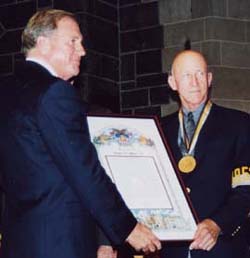
LTG (R) Walter F. Ulmer, Jr. ’52
Throughout a long and distinguished career of service to the nation, Lieutenant General Walter F. Ulmer Jr., has epitomized the ideals of “Duty, Honor, Country.” As a soldier, commander, visionary, and educator, he has always been known for his straightforward, effective practice of enlightened leadership. This theme in his professional life, coupled with his unwavering courage and integrity, made a far-reaching and enduring impact upon countless soldiers, the Military Academy, the United States Army, and the world of business.
Read More
Born in Bangor, Maine, Walter Ulmer graduated from West Point in the Class of 1952. Commissioned a second lieutenant of Armor, he was immediately immersed in the rigors of unit leadership, commanding companies in the 56th Amphibious Tank and Tractor Battalion in Korea, the 6th Tank Battalion, 24th Infantry Division in Japan, and the 325th Airborne Infantry Regiment of the 82nd Airborne Division. During these assignments, the development of practical advice for junior leaders became one of his life-long professional interests.
In 1958, he was assigned to the Department of Military Topography and Graphics at West Point, and, following that tour, he attended the Command and General Staff College. After graduation he deployed to Vietnam, serving with the U.S. Military Assistance Command and as senior advisor to a Vietnamese Infantry regiment. Upon his return to the United States, he held high-level staff positions and commanded the 1st Squadron, 17th Cavalry, 82nd Airborne Division from 1967 to 1968.
General Ulmer then attended the Army War College and was subsequently selected for duty on its faculty. There, he directed a comprehensive and seminal study of leadership within the Army, profoundly influencing the way its techniques were inculcated throughout the Army of the 1970s.
In 1972, then-Colonel Ulmer returned to Vietnam, where he was Chief, Combat Assistance Team 70, during 62 days of intense combat in the Battle and Siege of An Loc. For its extraordinary heroism against a North Vietnamese force greatly outnumbering the Army Republic of Vietnam defenders, Combat Assistance Team 70 was awarded the Presidential Unit Citation. The citation documents the team’s pivotal role in turning back the North Vietnamese Army’s massive surprise offensive of 1972. During the fighting, Ulmer and his team coolly coordinated vital operations while An Loc was pounded day and night by the war’s heaviest and most sustained artillery and tank assaults. The team’s actions helped to save Saigon for another three years, assuring the safe withdrawal of the remaining U.S. combat forces in Vietnam, and assisting in making possible the January 1973 peace agreement and release of American prisoners of war.
In 1973, General Ulmer completed a master’s degree in Regional Planning from Pennsylvania State University. Subsequently, he was commander of the 194th Armor Brigade and, then, Deputy Commander, U.S. Army Armor Center, Fort Knox.
In 1975, Brigadier General Ulmer returned to West Point as the 56th Commandant of Cadets. During especially challenging times at West Point, he emphasized the importance of command presence and increased the interaction between cadets and senior leaders at the Academy.
General Ulmer’s astute and inspiring leadership was equally effective during his command of the 3rd Armored Division in Germany and, later, during his service as Commanding General, III Corps, Fort Hood, Texas. Following promotion to Lieutenant General, he commanded III Corps from 1982 to 1985, receiving national attention as he implemented lessons learned during his three decades of leadership study and experience. General Ulmer’s straightforward approach to command and clear sense of purpose prepared the corps for a wide range of contingencies and positively influenced the command climate elsewhere in the Army.
In 1985, General Ulmer retired after thirty-three years of distinguished military service. His awards and decorations include the Silver Star with Oak Leaf Cluster, the Distinguished Service Medal, the Bronze Star with Oak Leaf Cluster, the Air Medal with “V” Device, and decorations awarded by the Republic of Korea, the Republic of Vietnam, and the Federal Republic of Germany.
General Ulmer has carried his life-long study of leadership into the world of business, successfully bridging the gap between the military and the academic and corporate worlds. For example, from 1985 to 1995 he served as President and Chief Executive Officer of the Center for Creative Leadership and presided over the dramatic expansion of that nonprofit organization. It grew into an internationally recognized center of excellence, rated by national business publications as the leader in executive development.
This year, the U.S. Army War College and Dickinson College announced their choice of General Ulmer to serve as the General of the Army Omar M. Bradley Chair of Strategic Leadership, a position jointly established by the two institutions. In recent years, General Ulmer has also remained engaged with West Point and its graduates. He has been a member of the Board of Trustees of the Association of Graduates and repeatedly contributed his time and expertise to a variety of West Point Society activities.
Through a lifetime of service to West Point, the Army, and the nation, Walter Ulmer has immeasurably advanced the understanding of leadership; exemplified the ideal of courageous, selfless service; and burnished the image of West Point. It is with great pride that the Association of Graduates of the United States Military Academy presents the Distinguished Graduate Award for 2002 to Lieutenant General Walter F. Ulmer, Jr., USMA Class of 1952.
Thomas B. Dyer
Chairman and CEO
GEN (R) Arthur E. Brown, Jr. ’53
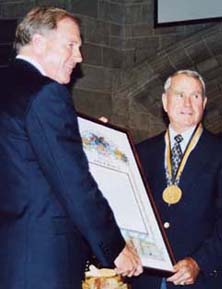
General Brown’s career of service to the nation began with his assignment as an Infantry platoon leader to the 508th Airborne Regimental Combat Team and reached its zenith with his selection for four-star rank and the position of Vice Chief of Staff of the Army. During a distinguished career of over thirty-five years, he also saw duty as both an advisor and battalion commander during two tours in Vietnam and served as Deputy Superintendent at West Point and Director of the Army Staff.
Read More
Upon retirement from active duty, he totally immersed himself in service to his community by membership on and leadership of various educational boards, foundations, commissions, and task forces. He also took a dynamic role as a trustee at large of the Association of Graduates and, later, as Chairman of the Alumni Support Committee.
Following Airborne and Ranger training, then-Lieutenant Brown became a rifle platoon leader with the 508th Airborne Regimental Combat Team; later, he would command a rifle company of the 60th Infantry Regiment as the Cold War intensified. Still later, then-Captain Brown traveled to the other side of the world to serve with the Military Advisory Assistance Group-Vietnam in 1962–63 and earn the coveted Combat Infantryman Badge, a Bronze Star, and an Army Commendation Medal for Valor. He then earned a master’s degree from the University of Pittsburgh before reporting for duty with the Directorate of Plans, Army Combat Development Command, and awarded a Legion of Merit for his work on the Assessment of Combat Effectiveness Study and the Dynamics of Firepower and Maneuver Study, as well as for his efforts as a member of the Pacification Role in Vietnam Study Group and his work with the Institute of Land Combat. In 1967–68, he served as executive officer to the U.S. Representative, NATO Military Committee in Belgium, garnering a Joint Service Commendation Medal.
Upon completion of the Army War College, he returned to Vietnam in 1969, this time to command an infantry battalion and serve as an advisor to the 9th Infantry Division, Army of the Republic of Vietnam. While commanding the 1st Battalion, 52nd Infantry Regiment, of the Americal Division, then-Lieutenant Colonel Brown was awarded the Silver Star and the Bronze Star for Valor. He also earned the Legion of Merit, Distinguished Flying Cross, and numerous Air Medals. Returning to the Army War College as Director, Arms Control and Disarmament Studies, he later served as Director, General Purpose Forces Strategy Studies. He planned and coordinated the Arms Control and Disarmament Elective and chaired the Current Affairs Panel, earning a third Legion of Merit. After successful command of the 1st Brigade of the 1st Infantry Division, he spent 1975–78 as a division chief and executive officer in the Office of the Deputy Chief of Staff for Operations, gaining a fourth Legion of Merit.
During 1978–80, then-Brigadier General Brown returned to troop duty as the Assistant Division Commander of the 25th Infantry Division in Hawaii. He then assumed the post of Deputy Superintendent at West Point, responsible for all administrative support and budget activities. During this time, he planned the welcome, housing, and transition of the American hostages released by Iran, earning a Meritorious Service Medal. In 1981, then-Major General Brown took command of Mobilization and Readiness Region IV, responsible for Reserve and National Guard units in five southeastern states, Puerto Rico, and the Virgin Islands.
In 1983, then-Lieutenant General Brown was assigned as Director of the Army Staff. During his tour, the Army staff oversaw the greatest modernization program since World War II. This included significantly upgrading both the tank and armored personnel carrier force and the aviation fleet while fielding four light infantry divisions. He also managed the staff reorganization mandated by the Goldwater-Nichols Defense Reorganization Act of 1986 and served as a member of the Stilwell Commission on security. He concurrently provided daily public affairs guidance on matters as diverse as the Gander aircraft tragedy, Operation Urgent Fury in Grenada, and the POW-MIA issue. For his work as the Director of the Army Staff, he was awarded the Distinguished Service Medal.
In June 1987, General Brown was appointed Vice Chief of Staff of the Army. He served as Chief of the U.S. Delegation to the 1987 American, British, Canadian, and Australian Conference on Military Standardization and provided analyses and advice on the Intermediate-range Nuclear Force Arms Control Treaty. He also implemented measures that improved the quality of life for service members and their families, reduced the ground and aviation accident rate, and enhanced maintenance productivity and spare parts availability. Upon retirement, his service was recognized with the conferral of both the Defense and Army Distinguished Service Medals.
In retirement, he continued his selfless service, not only as a trustee and committee chair with the Association of Graduates, but also in his community. He joined the board of the United Way of Beaufort County in 1990 and was named Volunteer of the Year for 1991–92. He became a trustee of the Technical College of the Lowcountry Foundation in 1992; served as chairman in 1994–97; and received the foundation’s Leadership Award in 1996. He joined the board of the Hilton Head Island Foundation in 1995; served as vice chairman in 1996–98; and was elected chairman in 1998. He also served as a volunteer with a number of other charitable, religious, and civic organizations.
For a lifetime of selfless service to West Point, the Army, and our nation, the Association of Graduates takes great pride in presenting the 2002 Distinguished Graduate Award to Arthur Edmon Brown, Jr., USMA Class of 1953.
Thomas B. Dyer
Chairman and CEO
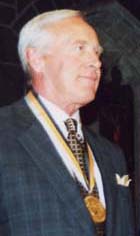
BG (R) Peter M. Dawkins ’59
A brilliant and outstanding leader who achieved great success as a cadet, as a commander and staff officer, and as a dynamic and innovative business executive, Peter Miller Dawkins has served his country and his Alma Mater with distinction and integrity throughout a professional career spanning over forty years.
Read More
Born in Michigan, Pete Dawkins entered West Point at the age of 17, embarking on a cadet career of unparalleled accomplishments. President of his West Point Class of 1959, First Captain and Brigade Commander of the Corps of Cadets, at the top of his class in academics, he was also an outstanding athlete who played football, ice hockey, and baseball.
In 1957, Eastern hockey coaches named him “finest sophomore in the East,” and two years later he led all Eastern college defensemen in goals scored, resulting in his being selected to the All-East hockey team. Pete captained the 1958 Army football team, the last Army team to finish the season unbeaten. He was a unanimous choice All-American at halfback and won the prestigious Maxwell Trophy, as well as the 1958 Heisman Trophy, awarded annually to the nation’s outstanding college football player. Pete Dawkins is only the third cadet to win the Heisman. The culmination of the many athletic honors he received was election to the National Football Foundation College Football Hall of Fame in 1975, at that time the youngest player ever selected.
Commissioned in the Infantry upon graduation from West Point, Lieutenant Dawkins, who had been awarded a Rhodes Scholarship, spent the next three years as a student at Brasenose College, Oxford University in England. Reporting to the 82nd Airborne Division in 1963, he commanded a company and served as Assistant G-3, Operations, where he developed a comprehensive Division Outloading Plan, a first for the 82nd Airborne Division. While attending the Infantry Officers Career Course a year later, Captain Dawkins led a committee that studied the curriculum of the course; the results of the study were implemented and greatly enhanced the education of young officers at Fort Benning. Captain Dawkins’ seminal article, “Freedom to Fail,” published in Infantry magazine the same year, won the Marshall Award for excellence in professional writing.
Assigned as Senior Advisor to the First Airborne Battalion of the Vietnamese Airborne Brigade, and later to the Military Assistance Command Pacification Office, Saigon. Pete Dawkins was awarded the Combat Infantry Badge, two Bronze Stars with “V” for valor, the Air Medal, and the Joint Services Commendation Medal.
Posted to the United States Military Academy, Major Dawkins was an instructor in the Department of Social Sciences, and co-director of the National Security Seminar. Midway in this tour, he returned to Vietnam at the request of General Westmoreland for a three-month field assignment focusing on the Revolutionary Development Program. His study led to an important strategy critique of the Military Assistance Command’s war plan.
In 1968, Major Dawkins became a student at Princeton University. In 1970, he was awarded the degree of Master of Public Affairs, and, in 1979, Princeton awarded him his Doctorate. Pete Dawkins joined the Office of the Special Assistant for the Modern Volunteer Army, working on the Army’s transition from draft status to an all-volunteer force. He was the principal author of the Modern Volunteer Army strategy document: “An Army People Want.” It was the blueprint the Army adopted. Back in the United States after a battalion command in Korea, he was appointed a White House Fellow, then Military Assistant to the Deputy Secretary of Defense. He attended the Army War College in 1975, and a year later Colonel Dawkins was assigned to Fort Ord, California, as Commanding Officer, Headquarters Command.
In 1979, Colonel Dawkins reported to the 101st Airborne Division (Air Assault) at Fort Campbell, Kentucky, where he served as Commander of the 3rd Brigade and later as Division Chief of Staff. In June 1981, he was promoted to Brigadier General and reassigned to the Office, Deputy Chief of Staff for Operations, Department of the Army. General Dawkins was Deputy Director and then Acting Director of the Strategy, Plans, and Policies Directorate and was awarded the Distinguished Service Medal upon his retirement from the Army in 1983.
Soon after relocating to New York City in 1984, General Dawkins was asked by the Vietnam Veterans organization to lead a fund drive to raise $2 million to erect a memorial and provide vocational and psychological counseling for veterans. General Dawkins, beginning with no organization or staff, completed this daunting task in fourteen weeks, raising over $3.5 million.
Pete Dawkins was honored by the Business Executives for National Security, receiving that organization’s Eisenhower Award given annually to an individual who exhibits unusual leadership in the realm of national security. That award resulted from Dawkins’ chairmanship of a high-level panel of chief executive officers of industry who looked into how the Department of Defense could benefit by the experiences of American industry.
Throughout a lifetime of distinguished service to the nation and his fellow citizens, General Dawkins has never wavered from his belief in the ideals and principles of the West Point motto: Duty, Honor, Country. Pete Dawkins’ outstanding leadership, selfless concern for his fellow man, and his personal and professional conduct have set a standard that future generations of West Point graduates will find difficult to emulate.
Accordingly, the Association of Graduates is proud to present the 2002 Distinguished Graduate Award to Peter Miller Dawkins, USMA Class of 1959.
Thomas B. Dyer
Chairman and CEO
GEN (R) George A. Joulwan ’61
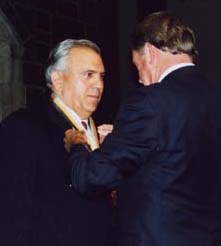
A distinguished soldier whose extraordinary achievements as Supreme Allied Commander, Europe, were instrumental in building a new post-Cold War security structure, a Commander-in-Chief of Southern Command who made a significant contribution to bringing peace to El Salvador and democracy to Panama, and a Commander-in-Chief, Europe, who conducted over twenty successful operations in the Balkans, Africa, and the Middle East without the loss of a single soldier to hostile fire, George Alfred Joulwan has served his country with distinction in a military career of over thirty-six years. In every assignment, from platoon leader to four-star general, George Joulwan has lived by the motto of the United States Military Academy: Duty, Honor, Country.
Read More
George Joulwan played football and basketball as a cadet, winning two letters in football as a lineman. Commissioned in the Infantry, he first served with the First Battalion, 30th Infantry of the 3rd Division in Europe. Posted to Vietnam, he was assigned to the First Battalion, 26th Infantry of the First Division. As Battalion Operations Officer (S-3), his commanding officer was General (then Lieutenant Colonel) Alexander Haig, who has termed him a “consummate warrior.” For his service in Vietnam, George Joulwan was awarded two Silver Stars, the Bronze Star with “V” device, four Air Medals, and the Army Commendation Medal.
Returning to the United States, Major Joulwan was assigned to Loyola University, Chicago, as Assistant Professor of Military Sciences, where he earned his Master of Arts degree in Political Science. After graduating from the Army Command and General Staff College in 1971, George Joulwan returned to Vietnam and served with the 101st Airborne Division. In 1972, he reported to West Point for a one-year tour with the Department of Tactics, and in 1973 he was appointed Aide-de-Camp to the Vice Chief of Staff, U.S. Army. A year later, Lieutenant Colonel Joulwan was named Special Assistant to the President of the United States. In 1975, he became Special Assistant to the Supreme Allied Commander, Europe, and later commanded the First Battalion of the 26th Infantry. He attended the Army War College, and served on the Staff and Faculty until 1979, when he returned to Germany to command the 2nd Brigade of the 3rd Infantry Division. He later served as Division Chief of Staff before returning to the Office of the Joint Chief of Staffs in 1982. General Joulwan was Director of Force Development, Department of the Army, until 1985 when he was appointed Deputy Chief of Staff for Operations, U.S. Army Europe and Seventh Army.
Major General Joulwan commanded the 3rd Armored Division in 1988, and became Commanding General of the V Corps in 1989.
In 1990, General Joulwan was appointed Commander-in-Chief, United States Southern Command. During his first ten days in command, he faced three coups, an insurrection in Panama, and a war in El Salvador. Through George Joulwan’s strong and decisive leadership and steadfast moral courage, he was able to bring peace to El Salvador and democracy to Panama. In addition, General Joulwan was successful in modernizing the military organizations of Latin America while increasing their professionalism. In a parallel effort, he made significant strides in reducing the trafficking in illegal drugs throughout the region.
George Joulwan’s final active duty assignment, from 1993 until he retired from the Army in 1997, was Commander-in-Chief, United States European Command and Supreme Allied Commander, Europe. Altogether, General Joulwan served eighteen years in Europe and was the first Supreme Allied Commander, Europe, to have commanded at every level from platoon through corps.
As SACEUR, General Joulwan established first-ever strategic policy for United States military engagement in Africa and orchestrated the State Partnership Program that linked American reserve forces from 23 states with former non-NATO countries and newly independent democracies of Eastern Europe and the Soviet Union. George Joulwan developed the concept of the Bosnia operation, and for eighteen months was the overall military commander of the Implementation and Stabilization Force involving thirty-six nations. He was instrumental in developing the Partnership for Peace Program, and due to his efforts and initiative, Russian and United States military forces conducted operations together in Bosnia. This cooperation, spearheaded by General Joulwan, was the basis for the historic NATO-Russian Founding Act signed in 1997 that ended the Cold War.
In addition to his many combat decorations, General Joulwan has been awarded three Defense Distinguished Service Medals, the Army Distinguished Service Medal, and the Legion of Merit twice.
Subsequent to his retirement, George Joulwan has continued to serve his country — as an advisor to private industry, a consultant in both the public sector and on senior defense boards, and as a teacher and educator. Most notably, he was the Olin Professor for National Security at the United States Military Academy.
Throughout four decades of dedicated service to his country, George Joulwan made permanent and invaluable contributions to the freedom and security of the United States. His sound military advice on the use of military power to support diplomacy and foreign policy were instrumental in ending the Cold War and bringing peace to the Balkans.
Accordingly, the Association of Graduates takes great pride in presenting the 2002 Distinguished Graduate Award to George Alfred Joulwan, USMA Class of 1961.
Thomas B. Dyer
Chairman and CEO

